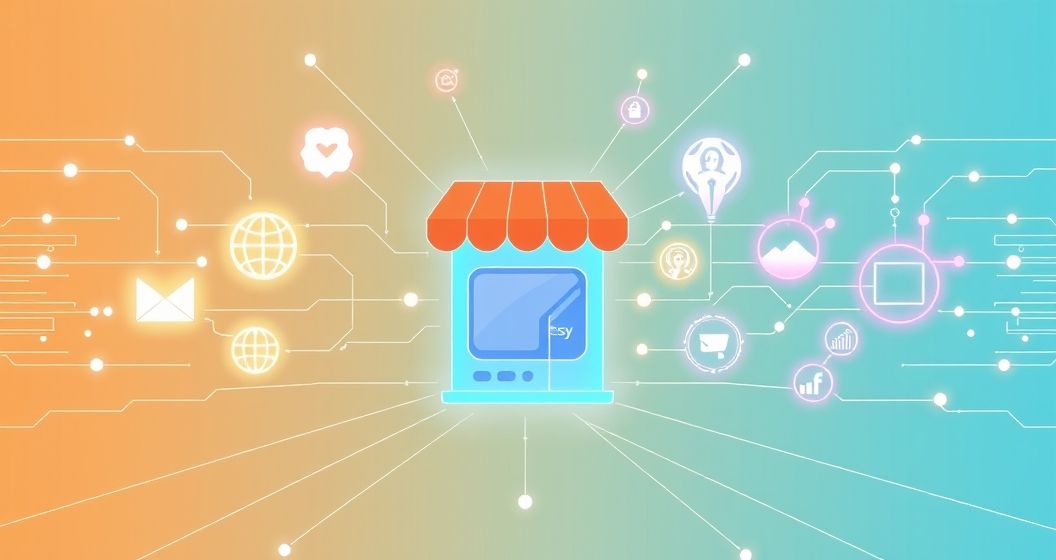In the dynamic world of online retail, Etsy has carved out a unique niche for artisans, crafters, and vintage sellers. As businesses grow, managing an Etsy shop can become increasingly complex, demanding significant time and effort. This is where Etsy integrations emerge as powerful tools, designed to streamline operations, enhance efficiency, and ultimately, free up sellers to focus on creativity and growth. Understanding and implementing the right integrations can transform a burgeoning Etsy store into a finely tuned, automated selling machine, allowing for scalability and reduced manual workload across various critical functions.
Understanding Etsy Integrations for Enhanced Selling
Etsy integrations refer to third-party applications or software solutions that connect directly with your Etsy shop. These connections allow for data exchange and automated tasks between Etsy and other platforms, services, or tools. The primary goal is to centralize operations, reduce repetitive manual tasks, and provide a more cohesive business management experience. From syncing inventory across multiple sales channels to automating shipping label creation, integrations are pivotal for modern Etsy businesses aiming for sustained growth and operational excellence without increasing their administrative burden. They act as a bridge, linking your Etsy storefront to the broader e-commerce ecosystem.
Key Benefits of Integrating Your Etsy Store
Adopting Etsy integrations offers a multitude of advantages that can significantly impact a seller’s productivity and profitability. These benefits extend across various operational facets, ensuring a more efficient and less stressful selling experience. The strategic implementation of these tools empowers sellers to reclaim valuable time, reduce errors, and focus on expanding their product lines and engaging with customers. Ultimately, integrations serve as a catalyst for professional growth and enhanced market presence for any dedicated Etsy entrepreneur seeking to optimize their daily workflow and business processes effectively.
1. Streamlined Inventory Management
Managing inventory is a critical aspect of any retail business, especially for unique or handmade items. Etsy integrations for inventory management automatically update stock levels across all your selling platforms whenever a sale occurs. This prevents overselling, reduces manual adjustments, and ensures accurate stock counts, saving countless hours of administrative work. By centralizing inventory data, sellers gain a clear, real-time overview of their product availability, enabling better purchasing decisions and minimizing discrepancies that can lead to customer dissatisfaction. Efficient inventory control is fundamental for maintaining positive customer experiences and operational integrity.
2. Automated Order Processing and Fulfillment
The journey from a customer clicking “buy” to receiving their item involves several steps, all of which can be automated. Order processing integrations automatically pull order details from Etsy, populate shipping software, and generate labels. Many solutions also send tracking information directly to customers, enhancing communication and satisfaction. This automation significantly reduces the time spent on manual data entry, decreases the likelihood of shipping errors, and accelerates the overall fulfillment process. Quicker dispatch times often lead to happier customers and more positive reviews, contributing to a strong brand reputation and repeat business opportunities.
3. Centralized Financial Tracking and Accounting
Keeping accurate financial records is essential for tax purposes and understanding business profitability. Etsy accounting integrations automatically sync your sales data, fees, and expenses with bookkeeping software. This eliminates the need for manual input, ensuring that your financial records are always up-to-date and accurate. Such integration simplifies tax preparation, provides clear insights into your revenue and expenditure, and supports informed financial decision-making. Having a precise financial overview is crucial for sustainable business growth and demonstrates professionalism to both stakeholders and regulatory bodies, ensuring compliance and long-term viability.
4. Expanded Sales Channels and Reach
Many Etsy sellers eventually look to diversify their sales channels to reach a broader audience. Integrating Etsy with other e-commerce platforms, such as Shopify or WooCommerce, allows for seamless management of listings, inventory, and orders from a single dashboard. This multi-channel approach significantly expands market reach without multiplying administrative burden. It enables sellers to tap into different customer bases and sales strategies, maximizing potential revenue streams. The ability to manage multiple storefronts concurrently through integrations is a strategic advantage, fostering growth and reducing the complexities associated with diverse online presences.
5. Enhanced Marketing and Customer Relationship Management
Effective marketing and customer engagement are vital for building a loyal customer base. Etsy integrations can connect your shop data with email marketing platforms, allowing for automated follow-up emails, promotions, and personalized communication. CRM integrations help manage customer inquiries, feedback, and purchase history, improving service quality. These tools enable sellers to nurture customer relationships, build brand loyalty, and drive repeat purchases through targeted campaigns. By understanding customer behavior and preferences, businesses can tailor their marketing efforts, leading to higher engagement rates and a stronger overall market position.
Popular Types of Etsy Integrations Explored
The landscape of Etsy integrations is diverse, offering specialized solutions for nearly every aspect of running an online store. These tools cater to various business needs, from core operational tasks to advanced marketing strategies. Understanding the different categories of integrations helps sellers identify the most suitable solutions for their specific challenges and growth objectives. Each type brings unique capabilities to the table, designed to optimize a particular facet of the e-commerce workflow. Exploring these options enables a tailored approach to business automation and efficiency.
E-commerce Platform Syncing: Connecting Etsy to Other Stores
For sellers with ambitions beyond Etsy, connecting their shop to other e-commerce platforms is a common strategy. Integrations facilitating this, often called multi-channel listing tools, allow businesses to manage products, inventory, and orders across platforms like Shopify, BigCommerce, or WooCommerce from one central hub. This eliminates the tedious task of manually replicating listings and adjusting stock levels on each site individually. The benefit is a synchronized product catalog and order flow, ensuring consistency and preventing overselling, while maximizing exposure to different customer segments across the digital marketplace.
Inventory and Order Management Systems
Dedicated Inventory and Order Management Systems (IMS/OMS) are robust solutions designed for sellers handling a significant volume of products or orders. These integrations provide advanced features such as batch order processing, automated shipping label generation, and comprehensive inventory tracking across multiple warehouses or locations. They offer detailed reporting and analytics, helping sellers identify trends and optimize their operations. For businesses experiencing rapid growth or managing diverse product lines, these systems become indispensable, transforming complex logistical challenges into streamlined, manageable processes, significantly boosting efficiency and overall control.
Shipping and Fulfillment Solutions
Efficient shipping is crucial for customer satisfaction. Integrations with shipping platforms automate the entire shipping process, from calculating rates and printing labels to generating customs forms and tracking shipments. These tools often integrate with major carriers, allowing sellers to compare shipping costs and choose the most economical or fastest option. Some solutions also offer discounted shipping rates, translating directly into savings for the business. Automating these tasks reduces manual errors, speeds up dispatch times, and provides customers with timely updates, contributing to a positive post-purchase experience and fostering loyalty.
Accounting and Bookkeeping Tools
Managing finances is often considered one of the less enjoyable aspects of running a business. Etsy integrations with accounting software like QuickBooks Online or Xero simplify this significantly. They automatically import Etsy sales data, fees, refunds, and other transactions, categorizing them appropriately. This provides a real-time, accurate overview of your business’s financial health, simplifies reconciliation, and streamlines tax preparation. By automating bookkeeping, sellers can reduce the risk of errors, save valuable time, and gain better insights into their profitability, enabling more informed financial planning and strategic decision-making.
Print-on-Demand (POD) and Dropshipping Integrations
For sellers specializing in custom designs or dropshipping, integrations with Print-on-Demand (POD) or dropshipping services are essential. These tools automatically transfer order details from Etsy to the fulfillment partner, who then prints and ships the product directly to the customer. This model eliminates the need for sellers to manage inventory, production, or shipping themselves. Popular services integrate seamlessly, allowing for a hands-off fulfillment process. This enables creative entrepreneurs to focus on design and marketing, expanding their product offerings without significant upfront investment or logistical complexities.
Choosing the Right Etsy Integration: Strategic Considerations
Selecting the appropriate Etsy integrations requires careful thought and a clear understanding of your business needs. With numerous options available, making an informed decision is paramount to ensure the chosen tools genuinely enhance your operations rather than adding unnecessary complexity. A strategic approach involves evaluating your current workflow, identifying pain points, and considering your long-term goals. Taking the time to properly research and compare solutions will lead to more effective implementation and a greater return on your investment in these powerful automation tools.
Assessing Your Business Needs and Goals
Before committing to any integration, thoroughly assess your current business operations. Identify the areas where you spend the most time, encounter the most errors, or experience bottlenecks. Are you struggling with inventory sync, order fulfillment, or financial tracking? Your specific challenges should guide your integration choices. Furthermore, consider your long-term business goals. Do you plan to expand to other platforms, offer new product types, or scale your production? Aligning integrations with your strategic objectives ensures they support your growth trajectory effectively and sustainably.
Evaluating Integration Costs and Return on Investment
Etsy integrations come with varying price structures, from free basic versions to premium subscription models. It is crucial to evaluate the cost of an integration against the potential time savings, error reduction, and increased efficiency it offers. Consider the total cost of ownership, including any setup fees or ongoing monthly charges. A cost-benefit analysis will help determine the potential return on investment (ROI). Even paid solutions can be highly cost-effective if they significantly reduce manual labor and allow you to scale your business without increasing overhead proportionaly, making them a wise investment.
Prioritizing Ease of Use and Technical Support
The best integration is one that is easy to set up, understand, and use daily. A complex or unintuitive interface can negate the benefits of automation by requiring extensive learning time or leading to user frustration. Furthermore, assess the quality and availability of technical support. Should you encounter any issues or have questions, prompt and effective support is invaluable. Look for integrations with comprehensive documentation, tutorials, and responsive customer service. Prioritizing user-friendliness and reliable support ensures a smooth integration experience and minimizes potential disruptions to your business operations.
Maximizing Efficiency with Multi-Channel Etsy Integrations
For Etsy sellers venturing into multi-channel commerce, integrations become indispensable tools for maintaining consistency and efficiency across all platforms. These solutions centralize product data, including descriptions, images, and pricing, ensuring that changes made in one place reflect across all storefronts. They synchronize inventory in real-time, preventing overselling regardless of where a purchase originates. Furthermore, multi-channel integrations consolidate orders into a single dashboard, simplifying fulfillment processes and customer communication. This holistic approach to sales channel management allows businesses to scale their reach without increasing operational complexities, fostering seamless growth.
The Future of Etsy Selling: Leveraging Integrated Solutions
As the e-commerce landscape continues to evolve, the importance of robust Etsy integrations will only grow. These tools are no longer just optional add-ons but essential components for any Etsy seller aiming for long-term success and scalability. By embracing automation and leveraging the power of integrated solutions, sellers can transform their operations, moving beyond manual tasks to focus on creativity, customer engagement, and strategic business development. The future of Etsy selling lies in smart, connected systems that empower artisans and entrepreneurs to thrive in a competitive digital marketplace, ensuring efficiency and sustained growth for years to come.






